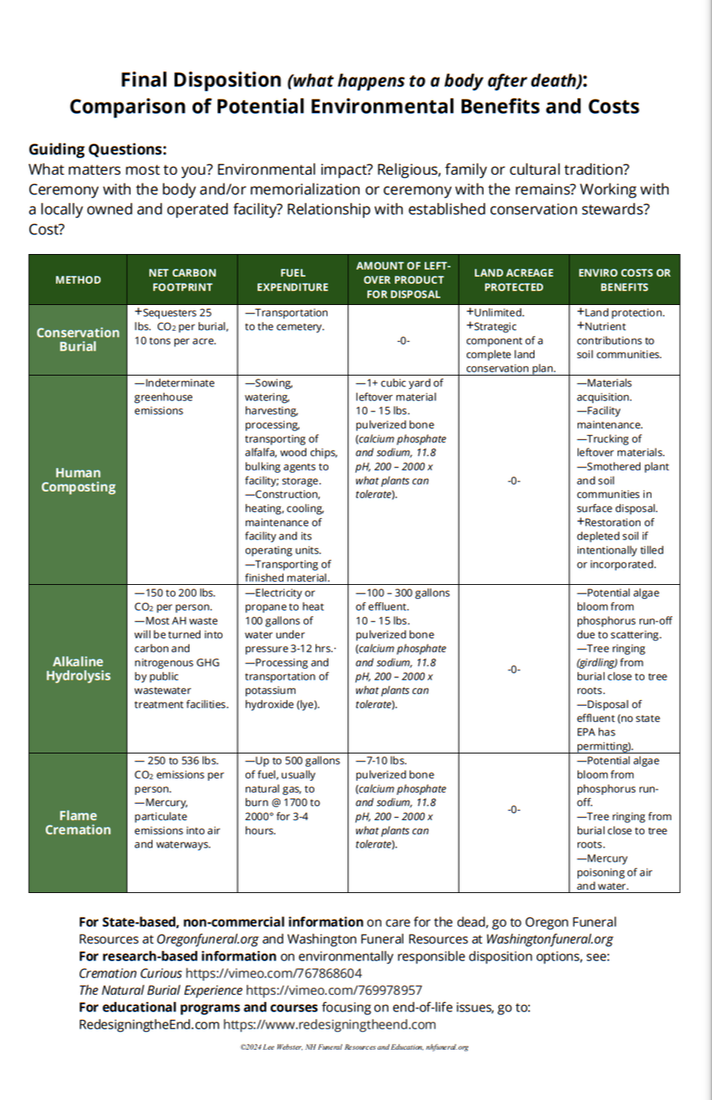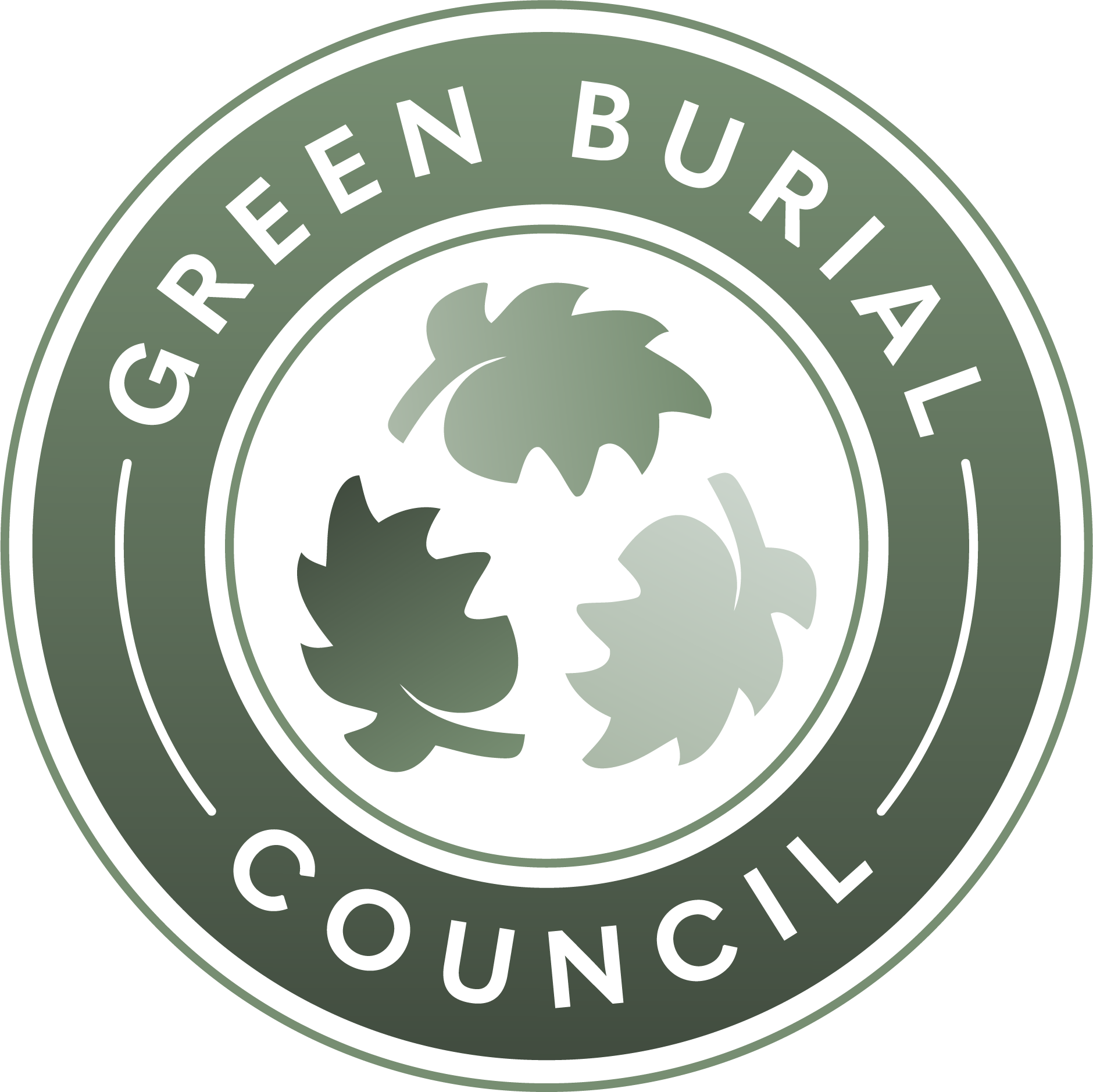Press
Press Inquiries
For media inquiries, please fill out the brief contact form below or email us directly at info@greenburialcouncil.orgThe Basics of Green Burial
Reporting on green burial can be tough to navigate. Terms are often used inconsistently, and environmental claims can be difficult to verify. As the leading authority on green burial, the Green Burial Council is committed to providing clear, accurate, and trustworthy information for responsible media coverage.
If you're new to the topic, start with the basics on our What is Green Burial? page.
Disposition Statistics
From Lee Webster and the Green Burial Council:
Total estimated number of green burial cemeteries in the United States and Canada as of November 1, 2024 is 470 (though there are more that do not require vaults or have not been reported). For a complete list that is updated regularly go to Green Burial Cemeteries in the US and Canada.
Total number of active GBC-certified providers as of November 1st, 2024:
- 179 funeral homes
- 41 hybrid cemeteries
- 23 natural cemeteries
- 9 conservation cemeteries
- 12 product providers
Please note: Certification by the GBC is a choice not a requirement. Many cemeteries follow GBC standards without opting for certification. Please call ahead to inquire.

Worker safety is at risk in cemeteries, factories, and embalming facilities and funeral homes:
- 13% higher death rate for embalmers (Centers for Disease Control, Final Rights by Lisa Carlson and Joshua Slocum)
- 8 x higher risk of leukemia than the general population (11.24.09 Journal of National Cancer Institute)
- 3 x higher risk of ALS for embalmers (7.13.15 Journal of Neurology, Neurosurgery & Psychiatry)
- Other disease abnormalities in embalmers (1990 Journal of American Industrial Medicine)
- Higher than average incidence of COPD, respiratory diseases, and neurological disorders among maintenance workers
- WHO, CDC, OSHA address infectious disease control for embalmers (Funeral.EliteCME.com)
- A recent class action suit against Round-Up™ is pertinent to cemetery maintenance workers who develop Non Hodgkins Lymphoma
- Mercury contamination despite cremation smokestack scrubbers (Britain study 16%, Minnesota study 14%)
- 2022 NFDA Survey 60.5%
- Kates-Boylston 2021 interested in green funerals 91%
- Kates-Boylston 2021 interested in green burials 84.4%
- 2015 GBC Survey of cemeterians: 45% of families would have chosen cremation
- Medium article exit poll 2016 79%
- FAMIC Harris Poll 2015 64%
- US Catholic Magazine 2011 80%
- Kates-Boylston 2008 article mentioning poll 43%
- AARP 2007 42%
2014 — 2019
From Mary Woodsen of Cornell University and Greensprings Natural Preserve in Newfield, New York:
Burials in the United States use approximately:
- 4.3 million gallons embalming fluid, 827,060 gallons of which is formaldehyde, methanol, and benzene
- 20 million board feet of hardwoods, including rainforest woods
- 1.6 million tons of concrete
- 17,000 tons of copper and bronze
- 64,500 tons of steel
- Caskets and vaults leaching iron, copper, lead, zinc, and cobalt
From info provided by: Steve Talley, 2001: Equipment Sales Team, Matthews Cremation, Apokpa, FL 32703; (407) 886-5533 ext 123; stalley@matw.com
Trips to the Moon: Cremation and Energy Use in the United States
Ever wonder how far you could travel on the energy used in one year to cremate people in the United States? Probably not, but it’s surprising. To have some gauge of mileage, let’s consider a car that gets 30 mpg, and for perspective on the distance, we’ll speak in terms of trips to the moon. After crunching the numbers and triple checking our work, the answer is — hold on to your hats — over 1300 round trips to the moon! As they say, your mileage may vary, but here’s how we did the science based on what we believe are very reasonable assumptions. The quantity of energy used to cremate people is expressed in units of therms — where one therm equals 100,000 BTUs of heat energy — and can range from about 12 therms to 50 therms per cremation. Our assumed average for this calculation is 25 therms, based upon information from Steve Talley of Matthews Cremation in Apokpa, FL. Considering that the oomph of one gallon of gasoline is equivalent to 1.24 therms, we can begin to visualize the magnitude of the energy expended for the 1,040,923 cremations in the U.S. for the year 2010. [That number of cremations is based on the 2010 resident population of 308,745,538 and the death rate of 8.3 per thousand (2,562,588 deaths). Considering that the cremation rate that year was 40.62 percent, there would have been 1,040,923 cremations.] Knowing that 1.24 therms equates to one gallon of gas, the 25 therms of energy per cremation corresponds to the energy contained in about 20 gallons of gas. Multiplying by the 1,040,923 cremations gives us a whole lot of gas to drive our car — 20,818,460 gallons. Traveling 30 miles for each gallon, we’d be way over warranty at 624,553,800 miles. Putting this into perspective, with the moon a mere 238,855 miles away, we could have journeyed over 2600 times that distance, making the round trip to the moon about 1307 times that year! That’s well over three round trips every single day for the entire year. Cremations consume incredible energy. I’d rather return to the Earth just once.
From The Ecology Action Center, Green Burial Nova Scotia:
Burials in Canada approximately:
- 4,500 litres of formaldehyde-based embalming fluid
- 97 ton of steel
- 2,000 ton of concrete
- 56,000 board feet of tropical hardwood in every acre of space
Cremation in Canada:
- Uses 92 cubic meters of natural gas
- Releases 0.8 to 5.9 grams of mercury
- Equals an 800 kilometer car trip
From Sam Bar, quality assurance and manufacturing engineer:
Cremation is erroneously thought by many to be greener:
- Uses fossil fuels to reach and maintain 1900° F for two-plus hours
- Releases mercury into air and water (Britain study 16%, Minnesota study 14%)
- Produces 139 lbs. - 250 lbs. CO2 pp = 1.74 billion pounds of CO2 emissions annually in the United States
- Includes byproducts of nitrogen oxide, dioxins, and particulates, producing acid rain
- Produces a final product of calcium phosphate and sodium
From Bob Jenkins and Dave O. Carter, Verde Products, Inc., on the GBC Blog April 2019:
Let’s take a look at the 1.4 million and 1.3 million decedents who underwent cremation and conventional burial, respectively, in the United States in 2017. If we assume that on average, each of these decedents weighs 110 pounds (50 kg) this means that the following elements were prevented from decomposing:
- 25 million kg of carbon (25,000 metric tons of carbon)
- 4.3 million kg of nitrogen (4300 metric tons)
- 1.3 million kg of phosphorus (1300 metric tons)
- 540,000 kg of potassium
